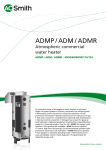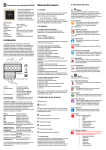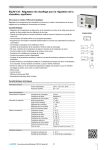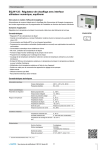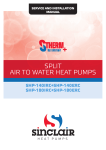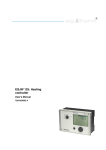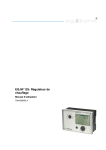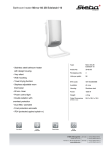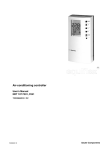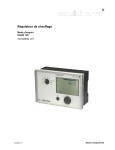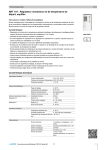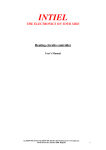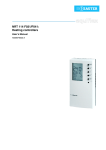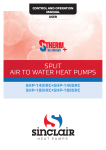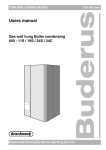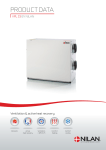Download Data sheets
Transcript
Product data sheet 44.430 EQJW 135: Heating controller for boiler control systems, equitherm How energy efficiency is improved Weather-dependent control of the boiler temperature and integrated automatic cut-off for the heating to save energy Features • Weather-dependent boiler- and/or supply-temperature control, and drinking water circuit in buildings of all kinds • Convenient to use with modern operating concept (turn and press) and large LCD • Communication via Modbus RTU or proprietary device bus • Convenient weekly and calendar switching programmes with optimisation of switching times • Automatic summertime/wintertime changeover • Limitation of boiler temperature and function for boiler start-up relief • Min./max. limitation of supply temperature and maintenance of return temperature • Frost-protection facility and anti-jamming function for valve • Screed curing (floor-drying functions) • Function for protecting against legionellae • Connection of room temperature via room-temperature sensor or room operating unit • Ni1000 inputs for the outside, supply, boiler, DHW, return and room temperatures or for room operating unit • Relay output for activating control units and pumps and for enabling burner levels, additional multifunctional relay output • Manual mode • Logbook • Notification by text message • Electrical connection in baseplate EQJW135F001 Technical data Power supply Parameters Control characteristic Control parameters Temperature ranges Power supply 230 V~, ±15%, 50...60 Hz Power consumption Approx. 1 VA Boiler temperature 2-point Supply temperature PI control Domestic-hot-water temperature 2-point Proportional band 2...100 K Integral action time 15...1000 s Switching difference, boiler 1...9 K Switching difference, domestic hot water 1...19 K Frost-protection temperature 3 °C Normal temperature 0...40 °C Reduced temperature 0...40 °C Supply temperature 0...130 °C Return temperature 0...130 °C Boiler temperature 0...130 °C Outside temperature –50...50 °C Domestic-hot-water temperature 20...90 °C Running time of valve 30...300 s Cycle time Running time of the valve ÷ 15 Ambient conditions Admissible ambient temperature 0...50 °C Admissible humidity 5...95% rh, no condensation Storage and transport temperature –25...65 °C Number of inputs 1 digital, 6 analogue Inputs/Outputs Right of amendment reserved © 2015 Fr. Sauter AG 7.1 1/7 Product data sheet 44.430 Digital inputs Switching current approx. 1 mA Analogue inputs 5 Ni1000, 1 Ni1000/room operating unit Number of outputs 6 relays Pump relay1) 3 × 2 A, 250 V~, cos φ > 0.5 Actuator relay2) 2 × 0.5 A, 250 V~, cos φ > 0.5 Relay to enable burner 0.5 A, 250 V~, cos φ > 0,5 Configurable relay3) 1 × 2 A, 250 V~, cos φ > 0.5 Function Digital timer for weekly/calendar switching programme Accuracy < 1 s/d Back-up power supply Min. 24 h, typically 48 h Weekly switching programme Number of programmes 3 Calendar switching programme Number of switching commands 48 each Min. switching interval 10 min Number of programmes 1 (for heating circuits) Number of switching commands 20 each Min. switching interval 1d Interface RS-485, device interface (similar to RS-232) Protocol Modbus, device bus (TAP) Weight 0.4 kg Dimensions 144 × 96 mm Interfaces and communication Construction Housing Pure white (RAL 9010) Housing material Fire-retardant thermoplastic Fitting Wall, panel, top-hat rail Screw terminals For wire of up to 2.5 mm² Standards and directives Type of protection (when fitted in pan- IP 40 (EN 60529) els) CE conformity according to Protection class II (IEC 60730-1) Energy class VII = 3,5 % acc. EU 811/2013, 2010/30/EU, 2009/125/EG Software class A EN 60730 EMC directive 2004/108/EC EN 61000-6-1, EN 61000-6-2, EN 61000-6-3, EN 61000-6-4 Low-voltage directive 2006/95/EC EN 60730-1 Overview of types Type Properties EQJW135F001 Heating controller for boiler control Accessories Type Description AVF*** Motorised valve actuator (see product data sheet) AVM*** Motorised valve actuator (see product data sheet) AXM*** Motorised valve actuator (see product data sheet) EGS 52/15 Room operating unit (see product data sheet) EGT*** External temperature sensor Ni1000 (see product data sheet) Modem Modems tested with the EQJW*** are available on request 7001059001 User manual, German 7001059002 User manual, French 7001059003 User manual, English 1) 2) 3) 2/7 Start-up current max. 7 A (1 s) Low voltage not admissible Start-up current max. 7 A (1 s); low voltage not admissible 7.1 Right of amendment reserved © 2015 Fr. Sauter AG Product data sheet 44.430 General description of operation The EQJW 135 heating controller performs weather-dependent supplier-temperature control and, depending on the application, also domestic-hot-water control and boiler temperature control. Various control models are stored in the EQJW 135 for the different applications. The temperatures (outside and supply temperatures and, depending on the application, the boiler, return, domestic hot water and room temperatures) are determined with precision sensors and digitalised in the controller. The microprocessor in the controller uses these values to calculate the signals for the outputs. Using the stored control model, the calculation of the output signals is based on the specified setpoints, along with the current actual values. Additionally, the current control offset, the set control parameters and the operating mode are considered. These signals are processed further via switching amplifiers. The results are the ON/OFF commands of the relay outputs for the control unit, the pumps and the burner. The room is supplied with the heat required to keep the room temperature constantly at the current setpoint. If a room-temperature sensor is connected to the EQJW 135 and parameterised, the current room temperature is considered in the calculation of the setpoint for the supply temperature. For the domestic-hot-water preparation, the charge pump is activated based on the measured domestic-hotwater temperature. The output relay for enabling the burner is activated based on the heat requirement and the current boiler temperature. The switching programmes, which the user can adapt individually, provide an optimal comfort level at the lowest energy consumption. The temperature setpoint for the room and the domestic hot water can be adjusted. The operating mode can be selected easily using the rotary switch. These can be used, for example, to switch off the heating or the domestic hot water for a longer period. The frostprotection facility prevents the system from freezing. The “temporary temperature change” function can be used to activate the party function or switch easily to another operating mode for a specific period, thus saving energy. The current operating status of the system is indicated in the LCD display, where the user can see it very easily at all times. A Modbus interface is used to communicate with the controller. It is also possible to connect multiple controllers with each other and connect a room remote-control unit with a digital user interface. A separate modem sends alarms via SMS if required. Intended use This product is only suitable for the purpose intended by the manufacturer, as described in the “Description of operation” section. All related product regulations must also be adhered to. Changing or converting the product is not admissible. Engineering note The equitherm EQJW 135 controller must be connected to the mains power supply all year round. Abbreviations TA Outside temperature TI TF Supply temperature TR Room temperature TRF Return temperature TB Boiler temperature TW Domestic-hot-water temperature Xp Proportional band Initial point (foot point) Tn Integral action time SP SERVice parameters Ty Running time of valve V UP Heating pump LP Charge pump for domestic hot water TS/W Heating limit S KW Cold water BW Domestic hot water Valve Slope of heating characteristic Symbol Factory setting q Normal mode (nominal mode based on EN 12098) Reduced mode a Off or back-up mode (with/without frost-protection facility) w Indexes Example Xs Setpoint TRs Room-temperature setpoint Xi Actual value TFi Actual value of the supply temperature Xged Damped value TAged Damped outside temperature max Maximum TFsmax Maximum supply setpoint min Minimum TRsmin Minimum room setpoint Right of amendment reserved © 2015 Fr. Sauter AG 7.1 3/7 Product data sheet 44.430 Additional technical data Measuring accuracy Better ±0.3 K at 25 °C Time constant for processing of measured values Approx. 10 s for TA, Neutral zone for supply temperature ±0.5 K < 5 s for TR and TF Minimum pulse duration for control 250 ms unit Follow-on time for heating pump 2 × Ty Follow-on time for LP Can be set on the SERVice level Heating characteristic Curved, without influence of extraneous heat Damping of outside temperature Time constant approx. 21 hours; can be (de)activated on the SERVice level Summertime/wintertime heating limit ON means summer → winter OFF means winter → summer ON for Taged< TS/W- 1 K OFF for Taged> TS/W Whereby TA can also be used for Taged. TS/W can be set using the SERVice parameters Back-up power supply The back-up power supply is typically 48 (min. 24) hours. The EQJW 135 must be supplied with mains power for at least 4 hours. Input for temperature sensor Ni1000 Zero-point correction for room tem- Up to ±6 K possible perature Zero-point correction for outside temperature Up to ±9 K possible Zero-point correction for return temperature Up to ±10 K possible Digital input If the voltage between terminal 22 and terminal 21 (DGND) is less than 1.5 V, the contact is interpreted as closed. If the voltage is greater than 2.5 V, the contact is interpreted as open. The current across the contacts is approx. 1 mA and the no-load voltage approx. 12 V=. Outputs Relay with indication of switching status Switching frequency, mechanical > 5 million switching cycles Maximum closing time, control unit Twice the running time of the valve. The control unit is reactivated every 15 minutes. Temporary temperature change Changes to the setpoint for the room temperature in automatic mode. Change until next switching command (however, minimum 2 hours), or from 3 hours to 19 days possible. Indication of the remaining time in the display. Termination of changes possible. Portion of extraneous heat A continuous occurrence of extraneous heat (e.g. caused by heat loss from machines) can be considered in the heating control. Design temperature If the EQJW 135 is in automatic mode and TA is lower than the set design temperature, the heating is controlled in normal mode independently of the switching programme. The design temperature is parameterised on the SERVice level. Special functions Room-tempera- The room-temperature connection is activated on the SERVice level. A room-temperature sensor ture connection is a prerequisite. The influence of the room-temperature connection can be adjusted on the SERVice level. Maximum change in TF based on room-temperature connection ±30 K. Frost-protection The frost-protection facility is activated if the operating mode of a control loop is in the OFF mode facility and the frost-protection facility has been enabled on the SERVice level. Additionally, the temperature must be below the anti-frost limit. The anti-frost limit is 3 °C for the outside temperature. The frost-protection facility is disabled when the outside temperature is above 4 °C. When the frost-protection facility is activated, a supply temperature of 10 °C is regulated for the heating circuits. If the domestic-hot-water temperature is < 5 °C, an increase to 10 °C is performed. 4/7 Anti-jamming function for pump The anti-jamming function for the pump is enabled on the SERVice level. Every day at midnight, a pump is activated for 60 seconds if it has not been operated for the previous 24 hours. This function is active in all operating modes apart from the manual mode. Multifunctional relay output One of the output relays (terminal 8) can be parameterised for a wide range of functions. This means the output can be used as a pilot clock output, as a collective alarm, for controlling a 2nd burner level, a boiler circuit pump, a heating pump for a 2nd heating circuit, or for the forced operation of the heating pump of heating circuit 1. 7.1 Right of amendment reserved © 2015 Fr. Sauter AG 44.430 Product data sheet Limitation of the The maximum and minimum setpoints for the supply temperature are limited. If a setpoint is calsupply tempera- culated for the supply temperature that is outside these limits, the limit temperature is regulated. ture The limit value is set on the SERVice level. In manual mode, the supply-temperature control is not active and therefore the limitation of the supply temperature does not apply. When the frostprotection facility is active, the limitation of the supply temperature is disabled. Limitation of TW The maximum setpoint for TW can be limited on the SERVice level. Anti-legionellae The weekly switching programme can be used to increase TW at regular intervals. If a higher TW function is required over a longer period independently of the switching programme, a separate switch is available for this. Limitation of the The maximum and minimum setpoints for the boiler temperature can be limited. Various condiboiler tempera- tions can be selected under which the minimum limitation is valid. A base temperature can be ture parameterised for the boiler. Controlling the One of the outputs of the EQJW 135 (terminal 8) can be used to activate a 2nd burner level. The 2nd burner level conditions under which the 2nd burner level is activated - such as outside temperature, temperature difference, delay time - are parameterised on the SERVice level. Boiler start-up relief If the boiler temperature gets too low, the boiler start-up relief is triggered. In the process, the charge is switched off until the boiler temperature is high enough again. The function is (de)activated on the SERVice level. Maintenance of The minimum actual value of TRF can be monitored. If the actual value of TRF falls below the return tempera- limit, the setpoint for TF is reduced. The limit value for the actual value of TRF and the influence ture on the setpoint for TF is parameterised on the SERVice level. Optimising the The optimising ensures that the heating is switched on and off at the optimal times in automatic switching times mode when the system changes between reduced mode or back-up mode and normal mode. The times are selected to ensure that the room-temperature setpoint is reached at the time specified in the switching programme. At the same time, energy is saved by switching the heating on as late as possible, and turning it off as early as possible. Manual mode In manual mode, the relays can be activated separately for the different outputs. The settings are performed in a menu if manual mode has been enabled. The manual mode is enabled on the SERVice level. In the factory setting, manual mode is “not enabled”. Automatic cutoff The heating controller uses its automatic cut-off to save energy wherever possible without any loss of comfort. The following options are available for switching off the heating circuit using the heating controller: a) The current operating mode for the heating circuit is OFF b) Summertime/wintertime heating limit OFF c) TA ≥ TRs (when TA ≤ TRs – 1 K, the controller switches on again) Floor-drying function Section 4 of EN 1264 describes how cement screeds must be treated with operational heating before putting down floor coverings. Initially, a supply temperature of 25 °C must be maintained for 3 days. After this, the maximum supply temperature must be maintained for a further 4 days. This function has been implemented in the EQJW 135. The function is called up on the SERVice level. An additional function is also available for screed curing. Switching programmes 3 weekly switching programmes with a maximum of 48 switching commands each and a calendar switching programme with a maximum of 20 switching commands are available. The minimum switching interval is 10 minutes or 1 day. An operating mode from the weekly and calendar switching programmes with lower energy consumption has priority. The calendar switching programme is enabled on the SERVice level. In the factory setting, the calendar switching programme is not enabled. The commands of the calendar switching programme are kept. Multiplication of The outside temperature is determined by an EQJW 135 and passed to the other controllers via TA the device bus as a measured value. The parameterisation for this is performed on the communication level. Logbook A logbook is available. Events that occur, e.g. a control offset that is too big or incorrect measured values, are logged. Modbus communication You can communicate with the EQJW 135 via an RS 485 interface using the Modbus/RTU protocol. Data can be exchanged. In the process, the EQJW 135 is always used as a slave. Notification via SMS A modem is used to send alarm texts as SMS to a mobile phone via a provider. An interface similar to the RS 232 is used for this. The TAP protocol (Telocator Alphanumeric Protocol) is used here. Disposal When disposing of the product, observe the currently applicable local laws. More information on materials can be found in the Declaration on materials and the environment for this product. Right of amendment reserved © 2015 Fr. Sauter AG 7.1 5/7 Product data sheet 44.430 Characteristics Heating characteristics for foot point TI = 20 °C Slope 3,0 2,5 3,5 4,0 2,0 100 1,8 90 [°C] 1,6 80 70 Slope 1,2 1,0 60 0,8 50 Flow temp. 1,4 0,6 40 0,4 30 TI -20 -15 [°C] -10 -5 0 5 10 [°C] 5 15 -5 Outside temp. -10 Characteristic for supply and boiler temperatures °C Flow-temperature Boiler temperature Setpoint 80 max. Boi le r Base temperature max. Hea t min. ing 40 flow min. 20 -20° -10° 0 10 Outside temperature Base point 20 °C 1 °C Example applications 2P T TA PI T TF M TB T T T LP UP (TR) BW T Tw TRF KW T Weather-dependent supply-temperature control with precontrolling of the boiler temperature and the domestic-hotwater control 6/7 7.1 Right of amendment reserved © 2015 Fr. Sauter AG 44.430 Product data sheet 2P 2P T T TA PI TA T TF M T TB T TB T T T UP (TR) UP T (TR) T TRF Weather-dependent boiler-temperature control Weather-dependent PI control of the supply temperature with precontrolling of the boiler temperature Connection diagram EQJW 135 L 2 230 V~ DVCC DATA2 DATA1 21 22 23 24 25 26 27 28 29 30 31 32 33 21 20 19 18 TB TA TF SP 46 M TR TRF DGND 10 TW 9 Ni1000 8 Ni1000 7 Ni1000 6 Ni1000 5 Ni1000 4 Ni1000 3 ext. 1 DGND N Modem TR 27 28 3 TR 27 28 4 0 4 EGS 52/15 EGT 333 27 28 0 1 19 27 28 3 2 EGS 52/15 EGT 333 18 B BUS A A10381b Dimension drawing 92 61 98 146 92 +0,5 0 138 138 +10 138 × 92 DIN 43700 Fr. Sauter AG Im Surinam 55 CH-4016 Basel Tel. +41 61 - 695 55 55 www.sauter-controls.com Right of amendment reserved © 2015 Fr. Sauter AG 7.1 7/7







